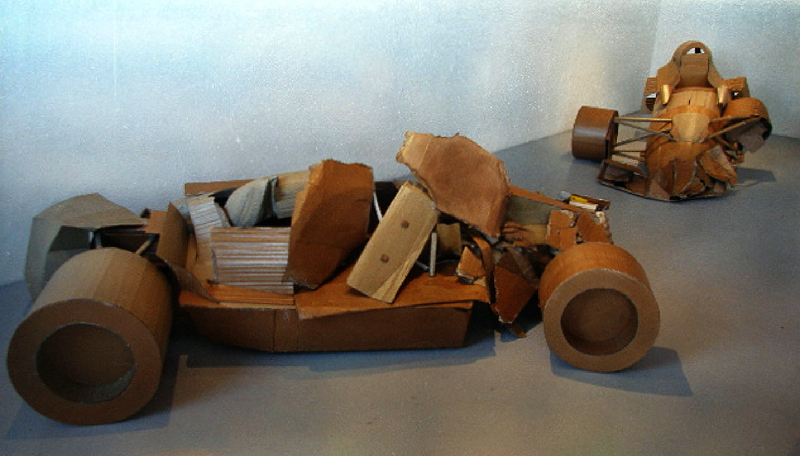by Johannes Lothar Schrder
1. The construction of car wrecks
Norbert Wilting is not
an unknown in Hamburg. 1993 he exhibited vehicle objects, monocoques
and
photographs in the gallery Cato Jans in the Hum- boldtstrasse 39 with
the term
"Faster", and made
it into the feature pages of the Hamburg press1 with the
photographs of
his constructed demolished Monoposti. As well exhibited splinters of
autobodies were varnished in the colors of the racing teams but the car
wrecks - named 'Timewreckages'
- kept the crude brown shade of
cardboard from which they were built scaled down. Hardly more to the
point than with the term Dekonstruktion,
which at that time was circulating in philosophical literature of the Yale Critics, could one have
allocated to
these works, if that term being applied to literature wouldn't have
evolved in a different frame of reference. After all it is that the
constuctions of destroyed formula-1- racing-cars double the
dysfunctionality of the autobodies that have merged in a different
condition already by the transformation of kinetic energy and
consequently were no longer possible to be entered in races. But it is
not directly acceptable why the visual availability of the wrecks is
supposed to be affected at the same time. Withdrawn from the eyes of
the public only the photographs of the accident cars circulate in the
media for a while. Contrary to that Wilting makes the bolides,
'deconstructed' by accident, to exhibition objects by which they become
objects accessible for an after-viewing. In this way the machines,
which are admired in a mass-cult, remain accessible also in the form of
their destruction, because made to art objects continuity can be
claimed for them.

But the transition from a public cult object in an object of cultural activities also reveals that there are areas where fetiches circulate that experience a different way of admiration and appreciation than the one that is common in cultural activities. But these wrecks, made from brown and gray cardboard and taken out of their time - the name 'timewreckages' 2 plays indeed with the temporary validity of their aura -, also show that there is a barrier between admiration and rejection and the space for criticism is sharply separated from the space for adoration of the speed mania. Because of the difficulty to expand the term 'Dekonstruktion' to art from the work with texts and as philosophical attitude it seems obvious to have another look at the car as an art object with the term 'hybrid' in mind.